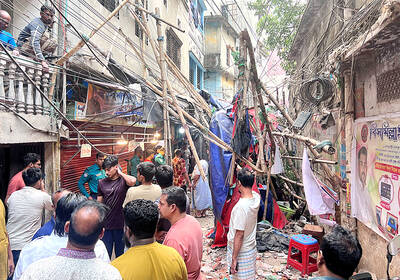Half the world's population will live in urban areas by the end of this year and about 70 percent will be city dwellers by 2050, with cities and towns in Asia and Africa registering the biggest growth, according to new UN projections released on Tuesday.
The report predicts that there will be 27 "megacities" with at least 10 million population by mid-century compared to 19 today, but it forecasts that at least half the urban growth will be in the many smaller cities with less than 500,000 people.
According to the latest UN estimate last year, world population is expected to increase from 6.7 billion last year to 9.2 billion in 2050. During the same time period, the new report said, the population living in urban areas is projected to rise from 3.3 billion to 6.4 billion.
"Thus, the urban areas of the world are expected to absorb all the population growth expected over the next four decades while at the same time drawing in some of the rural population," the report said. "As a result, the world rural population is projected to start decreasing in about a decade, and 600 million fewer rural inhabitants are expected in 2050 than today."
The report stresses that these projections will take place only if the number of children in families in the developing world continues to decline, especially in Africa and Asia.
At a news conference launching the 2007 Revision of World Urbanization Prospects, Hania Zlotnik, head of the UN Population Division, expressed hope that increasing urbanization "will go hand in hand with economic growth."
She said more than 70 percent of the population in Europe, North America, and many other richer developed countries already live in urban areas.
But only 39 percent of Africans and 41 percent of Asians lived in urban areas last year -- and these regions and other less developed countries are going to experience the most population growth in their cities and towns in the coming decades, the report said.
"During 2008, for the first time in history, the proportion of the population living in urban areas will reach 50 percent," it said.
"Globally, the level of urbanization is expected to rise from 50 percent in 2008 to 70 percent in 2050," the report said.
By mid-century, Asia is projected to see its urban population increase by 1.8 billion, Africa by 900 million, and Latin America and the Caribbean by 200 million, it said.
"While in the more developed regions, the proportion urban was already nearly 53 percent in 1950, in the less developed regions the 50 percent level will likely be reached around 2019," the report said.
Zlotnik said the UN expects Africa to reach the 50 percent mark between 2045 and 2050.
"Asia, if it continues to urbanize as rapidly as it's doing now, especially because of the rapid urbanized in China, is expected to become 50 percent urbanized around 2020-2025," she said.

DISASTER: The Bangladesh Meteorological Department recorded a magnitude 5.7 and tremors reached as far as Kolkata, India, more than 300km away from the epicenter A powerful earthquake struck Bangladesh yesterday outside the crowded capital, Dhaka, killing at least five people and injuring about a hundred, the government said. The magnitude 5.5 quake struck at 10:38am near Narsingdi, Bangladesh, about 33km from Dhaka, the US Geological Survey (USGS) said. The earthquake sparked fear and chaos with many in the Muslim-majority nation of 170 million people at home on their day off. AFP reporters in Dhaka said they saw people weeping in the streets while others appeared shocked. Bangladesh Interim Leader Muhammad Yunus expressed his “deep shock and sorrow over the news of casualties in various districts.” At least five people,

The latest batch from convicted sex offender Jeffrey Epstein’s e-mails illustrates the extraordinary scope of his contacts with powerful people, ranging from a top Trump adviser to Britain’s ex-prince Andrew. The US House of Representatives is expected to vote this week on trying to force release of evidence gathered on Epstein by law enforcement over the years — including the identities of the men suspected of participating in his alleged sex trafficking ring. However, a slew of e-mails released this week have already opened new windows to the extent of Epstein’s network. These include multiple references to US President Donald

LEFT AND RIGHT: Battling anti-incumbent, anticommunist sentiment, Jeanette Jara had a precarious lead over far-right Jose Antonio Kast as they look to the Dec. 14 run Leftist candidate Jeannette Jara and far-right leader Jose Antonio Kast are to go head-to-head in Chile’s presidential runoff after topping Sunday’s first round of voting in an election dominated by fears of violent crime. With 99 percent of the results counted, Jara, a 51-year-old communist running on behalf of an eight-party coalition, won 26.85 percent, compared with 23.93 percent for Kast, the Servel electoral service said. The election was dominated by deep concern over a surge in murders, kidnappings and extortion widely blamed on foreign crime gangs. Kast, 59, has vowed to build walls, fences and trenches along Chile’s border with Bolivia to

DEATH SENTENCE: The ousted leader said she was willing to attend a fresh trial outside Bangladesh where the ruling would not be a ‘foregone conclusion’ Bangladesh’s fugitive former prime minister Sheikh Hasina yesterday called the guilty verdict and death sentence in her crimes against humanity trial “biased and politically motivated.” Hasina, 78, defied court orders that she return from India to attend her trial about whether she ordered a deadly crackdown against the student-led uprising that ousted her. She was found guilty and sentenced to death earlier yesterday. “The verdicts announced against me have been made by a rigged tribunal established and presided over by an unelected government with no democratic mandate,” Hasina said in a statement issued from hiding in India. “They are biased and politically motivated,” she